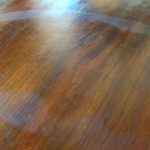How To Remove Polyurethane- A Simple Guide
Did the polyurethane on your furniture get scratched or damaged? If you’re worried about removing it, we’ve got you! It can feel somewhat intimidating, but it can be a fun do-it-yourself project with the right guidance.
So, how to remove polyurethane? You can easily apply some paint strippers and scrap them off. Besides, you can use lacquer thinner and denatured alcohol for the project or make your own homemade mixture using baking soda and vinegar. However, a heat gun is always an option if you know your way around it.
The method you choose depends on your convenience. Moving on, we will give you step-by-step guidance for all four methods. We’ve also mentioned some safety precautions. Make sure to follow them!
Arrangements To Make Before Starting
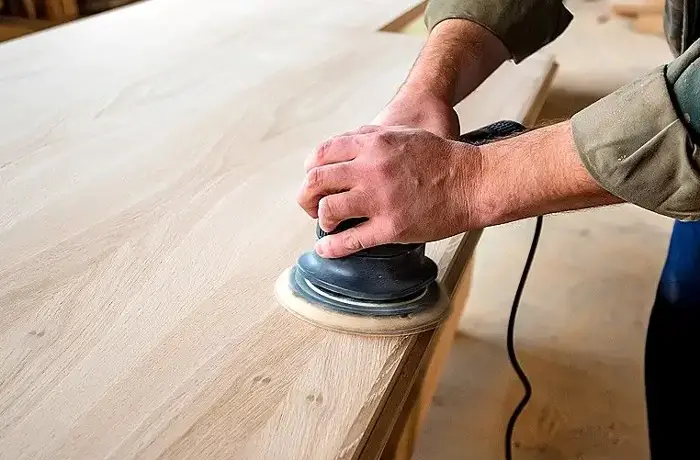
Before starting, take a few steps to protect yourself and your workspace.
- Although the methods are generally safe, you still need a well-ventilated room.
- Open all the windows and doors.
- Turn on the fans to let the fresh air pass.
- Remove any extra furniture from the room you’re working in. It might be time-consuming, but it will save you from creating a mess. However, if you can’t afford to do so, place a tarp on the floor and furniture to avoid any spillage.
- Lastly, you will need some protective gear, such as goggles, rubber gloves, and ventilator masks. Wear long pants, a full-sleeved T-shirt, and a good pair of close-toed shoes.
How To Remove Polyurethane?

Down below, we mentioned four different methods along with the tools required. Assemble the tools beforehand for your ease. You can choose whichever method suits you best.
Method 1: Using Paint Strippers
What you need before following the steps:
- Paint strippers
- Paint brushes or paint roller
- Metal or plastic scrapper
- Paper towel
- Paint stripper after-wash or detergent
- Sandpaper
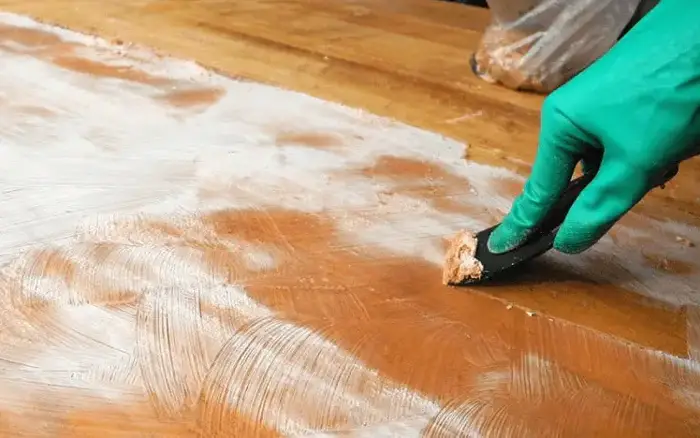
Step 1: Apply paint stripper
Using a paintbrush, apply a generous layer of paint stripper. Make sure the layer is even; otherwise, you will end up with patches of stripper. Cover up the corners smoothly; don’t rush the process.
Step 2: Let the paint stripper dry
If you use a chemical-based stripper, this step can be done in a few minutes. Your furniture can absorb the stripper in a maximum of 10 minutes. However, using water-based strippers usually takes 24 hours to completely dry. But This can depend on factors like the type of wood.
Step 3: Scrape off the polyurethane
You can use a plastic scraper or a metal one. However, plastic scrapers are safer as they won’t leave any scratches on your furniture. Gently start scraping it off. You don’t need to be harsh with it as the stripper does most of the job.
Step 4: Clean up
If you’ve scraped off as much polyurethane as possible, use a paint stripper after washing. Take some of it in a paper towel and wipe the furniture. If you don’t have access to an after-wash, use some detergent instead.
Step 5: Sand down the remaining
At this stage, most of the polyurethane should be gone. Gently scrub the surfaces with sandpaper to smoothen out everything.
Step 6: Add a new layer
This step isn’t necessary; it depends on what you need. You can either add a new layer of polyurethane for extra protection, or you can polish your furniture.
Method 2: Using Lacquer Thinner and denatured alcohol
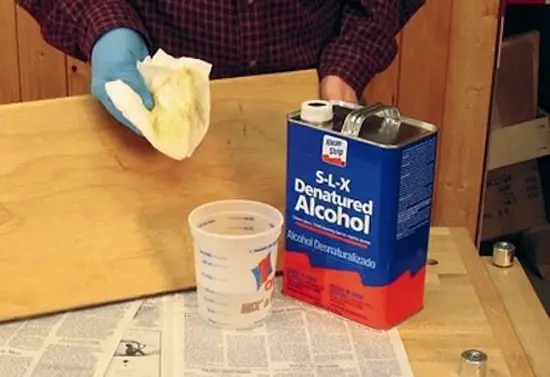
What you need:
- Lacquer thinner
- Denatured alcohol
- Bowl
- Paintbrush
- Scrapper or stripping pads
- Paper towel and warm water
Step 1: Prepare the mixture
In a bowl, add equal parts of lacquer thinner and denatured alcohol. With a wooden stick, mix it well to avoid any lumps from the lacquer. The texture will be thick but not lumpy.
Step 2: Apply the mixture
Use a paintbrush to apply the mixture all over the furniture. If needed, go for a second coat. You need to make sure everything is covered evenly.
Step 3: Scrape off the mixture
Don’t leave the mixture for more than 10 to 15 seconds. Use a scraper or stripping pads and gently scrape off the mixture. We recommend you not be too aggressive during this process. Take your time and be gentle.
Step 4: Clean up the furniture
Soak a paper towel in warm water and wipe the furniture with it. This is enough to complete the project. However, you can retouch it by polishing it!
Method 3: Using Baking Soda And Vinegar

What you need:
- Baking soda
- Vinegar
- Cornstarch
- Boiling water and cold water
- Paintbrush
- Wire brush or stripping pads
- Sandpaper
- Paper towel
- Detergent and water
Step 1: Prepare the mixture
In a bowl, add 1 cup of cornstarch with half a cup of cold water. Add 3/4th cup of baking soda in 4 cups of boiling water and 1 teaspoon of vinegar in a different bowl. Mix this up with the cornstarch mixture. You will end up with a thick paste.
Step 2: Apply the mixture
Generously apply the mixture to your furniture with a paintbrush. Cover it up evenly and let it sit for 10 to 15 minutes.
Step 3: Scrub off the mixture
Start scrubbing after the polyurethane starts breaking off the furniture. Use wire brushes or stripping pads and keep scrubbing them until you see the natural color again.
Step 4: Sand down the remaining
Using sandpaper will bring back the smoothness of the furniture. With heavy-duty sandpaper, keep sanding until you reach your desired smoothness.
Step 5: Clean and retouch
Wipe the furniture with a paper towel soaked in detergent and water. You can end it by polishing the furniture. However, this is completely optional.
Method 4: Using a heat gun
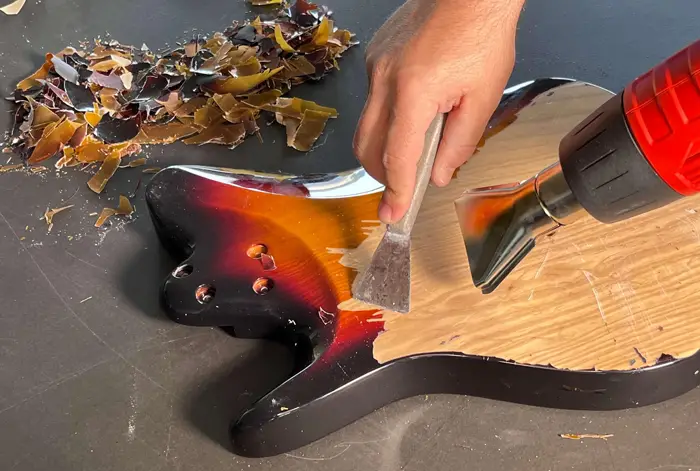
What you need:
- Heat gun
- Scraper
- Sandpaper
- Detergent and warm water
- Paper towel
Step 1: Wash the furniture
Before you start, wash the surface with detergent and soap water. Make sure to use a mild detergent; harsh chemicals in it might react with the heat. Finally, wipe the surface with a paper towel to dry it off.
Step 2: Start the heat gun
Hold the gun three to four inches away from the surface and start with medium temperature. Work with a small area at a time, and move the gun back and forth.
Step 3: Scrap
Once the polyurethane starts bubbling, stop the heat and start scrapping. Gently scrape off all the remaining polyurethane.
Step 4: Repeat
You may still notice some polyurethane stuck to your furniture. So, go back with the heat gun again. Then, scrape it all off.
Step 5: Sand down
Use fine-grit sandpaper to complete the project. This not only gets rid of the stubborn polyurethane leftover but also gives your furniture a smooth finish.
To guide you better, here’s a YouTube video for the process
FAQs
Now you know how to remove polyurethane. Still, we would like to answer some commonly asked questions to avoid any confusion.
Q. What type of paint strippers should I use?
Soy and citrus-based strippers are commonly used nowadays because of their eco-friendly nature. However, if you’re in a rush, use a chemical-based stripper.
Q. Are heat guns safe to use?
Heat guns are safe if you use them correctly and carefully. Don’t use it near any flammable objects and wear protective equipment.
Q. Can sandpaper remove polyurethane?
Using sandpaper alone can be very tedious and won’t give you the best results. We recommend you use paint strippers to get the task done efficiently.
Conclusion
So, how to remove polyurethane? There are a few ways to do it! The most common method is to apply some paint strippers of your choice. Let them sit for some time and scrape it off. You can finish it off by sanding down the furniture and polishing it.
Moreover, you use lacquer thinner and denatured alcohol or a mixture of cornstarch and vinegar. However, if you feel confident with such projects, you can just go in with a heat gun. You will get the same results from all methods if you follow the right steps. Good luck!




